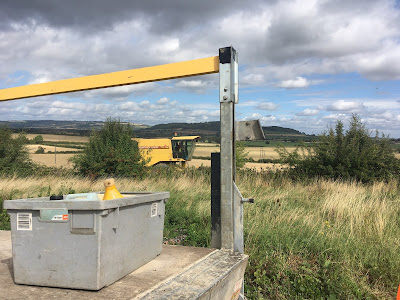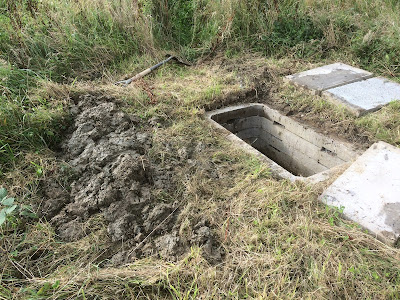Week Ending 29 August
Another 'Bitty' week, still nothing to get our teeth into.
Monday 26 Aug
The early week team of Dave and Nigel were in action at Royal Oak again, this time it was clearing the vegetation along the crest drain. It's going to be excavated at some stage to replace the stone layer on top of the pipe to improve the interceptor qualities of the drain. The water coming off the fields needs to be diverted away from the cutting slope, the crest drain should be doing this but neglect has allowed the stone to become clogged with earth and the water just shoots over the top.
They started with the new drain from the crest down to the cess on the down side.
First batch of photos from Dave.
 |
Nigel out finding chambers
|
 |
A bit of silt build up
|
 |
New plastic pipe runs into the cess chamber
|
 |
A bit more silt building up in here
|
 |
Crest Chamber on the site of the 2016 land slip
|
 |
Nothing running in from the land drains
|
 |
| Nigel stops to sign autographs for the fans |
 |
A couple of investigative holes were
dug to check on the pipe |
 |
SGW Pipe looks to be sound
|
Monday was the best day to be out and about weather wise, the rest of the week wasn't as pleasant.
 |
Looking back along the crest
Malvern Hills in the distance |
 |
Rush to get the crop in before the forecast storms
|
Thursday 27 August
Team Thursday (Andrew and Martin) had another day at Royal Oak, this time they had a change from vegetation clearance by doing a bit of shovelling and block removal. It's about making a start on the temporary improvement of the down side cess by removing every 5th horizontal block. This opens the way way for the ground to drain into the the cess pipe. Plans are underway to find a suitable way of filling the voids created, otherwise things like people will fall into them. More importantly they will fill with silt and cause more problems.
Report and photos from Andrew.
 |
Down side crest to cess chamber cleared
|
 |
Not much of sump in this one
|
 |
Cess chamber cleared, it didn't look that much from the top
|
The end of the cess drain is suffering a bit from limescale build up, it may look like a lava flow, but it's solid.
 |
Chamber between the cess and Culvert 24A
|
 |
The line of removed blocks in the down side cess
|
Rain stopped play after lunch, it started to hammer down so sensibly the team abandoned work for the day.
Friday 28 August
The rain was still coming down, so it was another short day. It did bring a change of scene though. The mission today to was discovering how the Winchcombe Cutting crest drain gets to the stream at the down side edge of Winchcombe Yard. The highways authority are planning to replace the deck on the bridge at Winchcombe Station, hence we need to know where our pipes are.
Our Structures Engineer arranged for access to the old Station House garden so that we could have look in a chamber in the corner.
 |
Roger and John looking for the chamber
|
 |
Bridge rail lid on the chamber
|
 |
Par for the course today, going good to soft
|
 |
Checking where the road gully drains to see where
the water runs |
The gullies along Greet Road run into a chamber that has an opening broken into it from the field on the tunnel side of the road. from there the water runs over into the chamber in the Station House garden.
 |
Surface water form the road gushing in
|
 |
Dye test in the Station House garden
|
On the cutting crest the last chamber before the bridge was opened to run some dye down to prove the flow route
 |
Water flowing in form the ditch in the field
|
 |
Air bag used to bung up the flow down to the cess
|
 |
| Bio-degradable marker dye |
 |
Dye from the crest running through to the house chamber
|
Roger tried tracing the pipe with the divining rods, but a water main runs along the road over the bridge which tends to interfere with the process
 |
| Looking for the drain run |
 |
| Cast marker plate in the footpath above the drain chamber |
Next step will be to run the sonde through from the garden in each direction to get a better bearing on the pipe.
Is there more excitement in store for the week ahead, we'll have to wait and see.




























A great job guys.
ReplyDeleteYou are beging to get the better of the drainage for the line but from the last articule it seems there are still some area's that need to be sorted, but great work guys. We did not know that limescale can build up in drainage pipes! Do you use a descaler for that? Another great report so thankyou for making time to do this for those of us still in lockdown.
ReplyDeleteRegards
Paul & Marion
We get a lot of limescale in the down side drains, it's the Cotswold limestone. I looked at liquid industrial descaler a couple of years ago, the cost was around 90p a ltr, this put it up in the region of £240,000 for the stretch from the Aqueduct to Stanton. The whole pipe had to filled and left to soak. On top of that was the disposal cost, it couldn't just be left to run out into the stream, it would need to be pumped out and taken away. It got too costly and complicated for us, as long as there's still room for water to run, uiit'll be left. If it gets too bad, replacing the pipes would be the cheaper option.
DeleteStuart
Thankyou Stuart for the reply, now you have explained it it makes sense, does seem like it could be a continual job!
DeleteRegards
Paul & Marion
Not sure I'd put much weight on diving rods! I'd go with the sonde, myself. :-) Glad to see it still seems to be working!
ReplyDeleteDye is of course also a reliable and informative tool, albeit fairly low tech! (Not that there's anything _wrong_ with low tech; in fact, if it does the job, it's probably a better choice: low-cost, robust, etc.)
I wonder how much there is still unknown about the GWSR's drains? You all have discovered a _tremendous_ amount over the last years, but I wonder where you all are on the 10%-90% scale? I'd _guess_ in the 70%-80% region, but that might be optimistic.
Noel